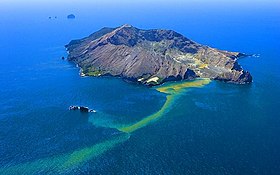Whakaari
| Whakaari/White Island | |
|---|---|
| Whakaari (Māori) | |

Whakaari/White Island, Bay of Plenty, New Zealand
|
|
| Highest point | |
| Elevation | 321 m (1,053 ft) |
| Prominence | 321 m (1,053 ft) |
| Coordinates | 37°31′S 177°11′E / 37.517°S 177.183°ECoordinates: 37°31′S 177°11′E / 37.517°S 177.183°E |
| Geography | |
| Location | Bay of Plenty, North Island, New Zealand |
| Geology | |
| Mountain type | Stratovolcano |
| Volcanic arc/belt | Taupo Volcanic Zone |
| Last eruption | 27 April 2016 - 9.30 pm |
Whakaari / White Island is an active andesite stratovolcano, situated 48 km (30 mi) from the east coast of the North Island of New Zealand, in the Bay of Plenty. It is New Zealand's most active cone volcano, and has been built up by continuous volcanic activity over the past 150,000 years. The nearest mainland towns are Whakatane and Tauranga. White Island has been in a nearly continuous stage of smoking at least since it was 'discovered' by James Cook in 1769.
The island is roughly circular, about 2 km (1.2 mi) in diameter, and rises to a height of 321 m (1,053 ft) above sea level. However this is only the peak of a much larger submarine mountain, which rises up to 1,600 m (5,249 ft) above the nearby seafloor. Sulfur mining was attempted but was abandoned in 1914 after a lahar killed all 10 workers. The main activities on the island now are guided tours and scientific research.
Whakaari's eruptions have produced both lava flows and explosive eruptions of ash. It is New Zealand's most well-known active marine volcano, attracting scientists and volcanologists worldwide as well as many tourists. It is part of the Taupo Volcanic Zone.
Volcanologists from the GeoNet Project continually monitor the volcano's activity via surveillance cameras. Survey pegs, magnetometers and seismograph equipment for early earthquake warnings via radio have also been installed on the crater walls. The island is usually on an alert level rating of 1 or 2 on a scale of 0 to 5. This volcano is monitored by the Deep Earth Carbon Degassing Project. At most times the volcanic activity is limited to steaming fumaroles and boiling mud. In March 2000, three small vents appeared in the main crater and began belching ash which covered the island in fine grey powder. An eruption on 27 July 2000 blanketed the island with mud and scoria and a new crater appeared. Major eruptions in 1981–83 altered much of the island's landscape and decimated the extensive pōhutukawa forest. The large crater created at that time now contains a lake, whose level varies substantially. Between July and August 2012 White Island showed signs of increased activity with lake and gas levels rising from inside the crater. On 5 August 2012 a minor eruption occurred, sending ash into the air. More eruptions have followed since.
...
Wikipedia

